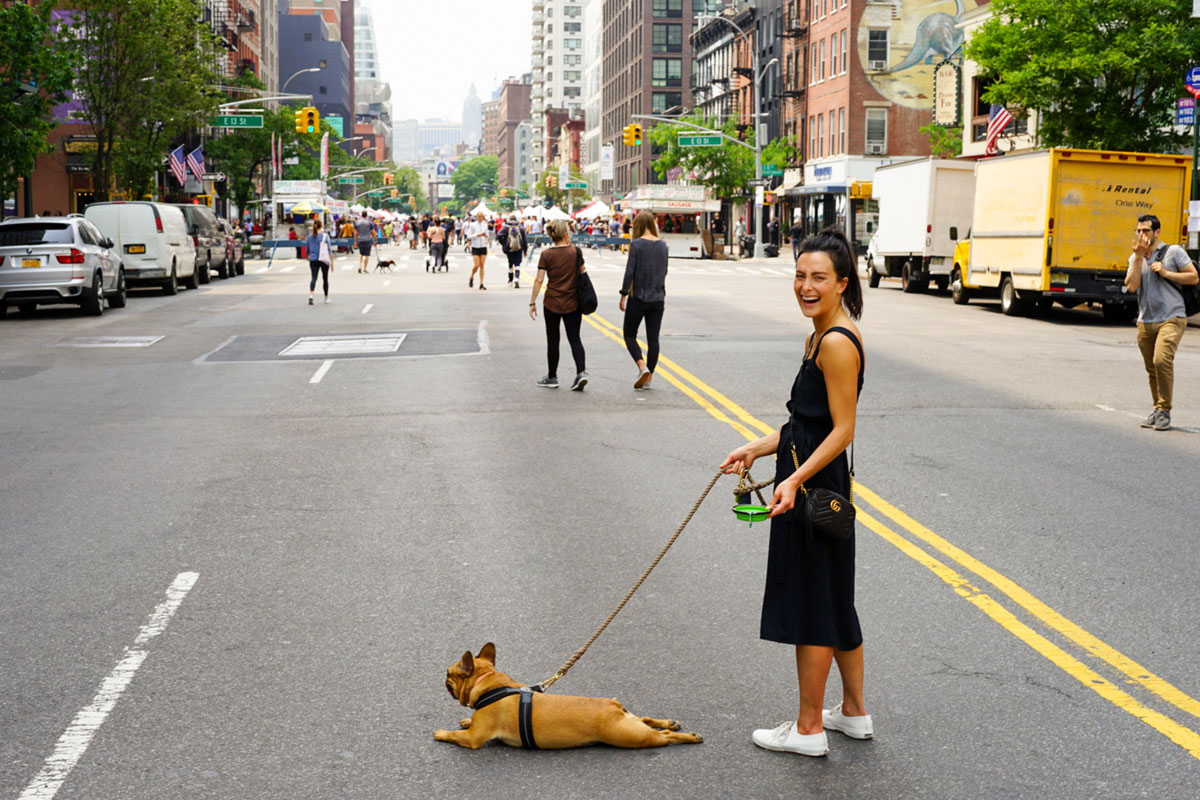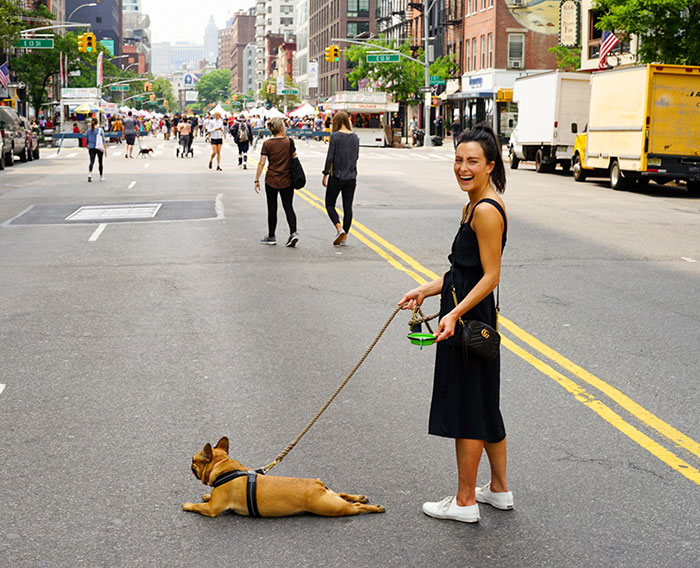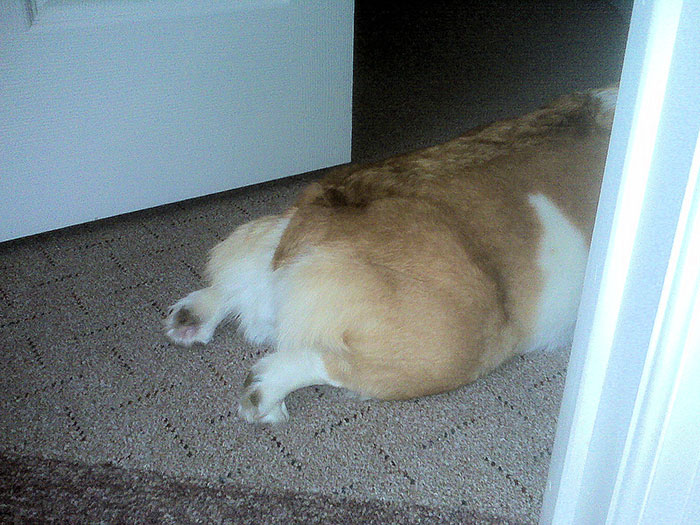If you’re a pet parent, you’ve likely witnessed the adorable “dog splooting” phenomenon. Even if you’re not, you’ve definitely seen it on social media!
Picture it: your furry friend lying on the ground, hind legs stretched out behind themselves, and maybe even a cute little wiggle in their tail. It’s a quirky and endearing sight, but what’s the story behind this peculiar canine stretch, and is it a cause for concern?
- Splooting is a relaxed pose where dogs stretch their back legs out.
- It's common in various breeds and can benefit joint flexibility.
- Excessive splooting may signal joint issues, warranting a vet visit.
- Splooting helps dogs stretch, cool off, and relax comfortably.
- Changes in splooting behavior can indicate health or comfort changes.
Let’s dive into the lighthearted world of splooting and uncover the meaning behind your dog’s charming yoga pose.
This post may include affiliate links.
The information provided herein is for informational purposes only. Please refer to our disclaimer for more details..
What Is Dog Splooting?
Image credit: Megan (Markham) Bucknall
To pet owners, ‘splooting’ is a popular term used to describe a cute and endearing posture that dogs sometimes assume when lying down. In a sploot, the dog stretches out one or both legs straight behind them, often with the front legs comfortably positioned forward.
It’s a relaxed and often amusing position where the dog’s belly is in contact with the ground, and the legs are splayed out, resembling a full or half stretch.
This position allows the dog to fully extend its hind legs backward, providing a good stretch for the hip and thigh muscles.
It’s commonly seen in various breeds and ages, with some dogs doing it occasionally for comfort or relaxation while others sploot more frequently.
While it’s typically harmless and can even benefit joint flexibility, excessive splooting or sudden changes in splooting habits might warrant a vet visit to rule out any underlying joint issues or discomfort.
Is a Dog Sploot a Cause For Concern?
Image credit: Virginia Hill, CC BY-ND 2.0 DEED
Fear not; splooting is generally harmless and often quite beneficial for your canine companion. In fact, it’s a natural behavior observed in various breeds, from the majestic German Shepherd to the tiny Chihuahua.
However, like all things in the pet world, moderation is key. If your dog occasionally assumes the sploot position, it’s likely just a quirk of their individual personality. Conversely, if your dog sploots excessively, it might be a cue to consult your vet to rule out any underlying joint issues.
What is the Purpose of Sploots?
Splooting may be a delightful stretch involving a dog lying down with their back legs stretched out behind them. This seemingly whimsical pose serves several purposes:
- Stretching the Hips and Joints: Splooting lets your dog stretch their hind leg muscles and joints, promoting flexibility and overall joint health. It’s like a small yoga session for your furry friend!
- Cooling Off: Dogs don’t sweat like humans, and splooting on a cool surface like a tile can help them regulate their body temperature. It’s their version of finding a comfortable spot on a hot day.
- Relaxation and Comfort: For many dogs, splooting is a sign of relaxation. When your pup is comfortable and at ease, they might naturally stretch out their hind legs behind them. It’s a canine expression of contentment.
- Natural Behavior: Some dogs simply enjoy the sensation of stretching. It’s a way for them to alleviate aches and pains, especially in their hips and joints.
Reasons Why Your Dog May Sploot
If your dog is a habitual splooter, there’s typically nothing to worry about. However, certain factors might contribute to more frequent splooting. Here’s some reasons why your dog is splooting:
Breed (The Corgi Sploot):
Some dog breeds are more prone to splooting than others. Corgis, for instance, are notorious splooters, often fully extending their hind legs in the signature “corgi sploot”.
Age (Puppy Splooting):
Younger dogs often sploots more frequently than older dogs. Sometimes they start to sploot as a way to cool down or simply just because they like splooting or find it amusing. A puppy may also sploot more often due to better flexibility in their hips compared to adult dogs.
Joint Issues In Older Dogs:
While occasional splooting is harmless, excessive splooting, especially in older dogs, might indicate joint issues like arthritis or hip dysplasia as it can alleviate some muscle or joint discomfort. If your dog is consistently splooting and you notice any signs of discomfort, a trip to the vet is in order.
Cooling Preference:
Dogs might sploot more often if they find it comfortable and cooling, especially on warm days or after running around. If your dog enjoys the sensation, they may naturally adopt the sploot position.
Breathing difficulties:
If your dog sploots a lot while also bending their neck straight back, it might be a sign of breathing difficulties. Typically, it is seen in brachycephalic breeds (flat-nosed breeds) like French Bulldogs and Pugs. If your dog does this frequently, it is well worth a trip to the veterinarian.
How to Interpret Your Dog’s Sploot Position: A Crash Course in Canine Body Language
Understanding your dog’s body language, including the sploot, can offer insights into their well-being and emotions. Here’s a quick guide to interpreting your dog’s sploot:
- Half Sploot: One leg extended, the other tucked under – a casual stretch or a sign of comfort.
- Full Sploot: Both hind legs are fully stretched out – a deeper stretch that involves more muscles and joints.
- Side Sploot: Legs stretched out to the side – a variation that might indicate relaxation or a preference for a particular lying position.
In essence, seeing your dog sploot is like catching a glimpse of their unique personality and the ways they naturally care for their well-being.
In Conclusion, Splooting Is Almost Always Nothing To Worry About
So, the next time you catch your dog in the midst of a joyful sploot, relish the moment! Whether it’s a full sploot, a half sploot, or a side sploot, your furry friend is simply expressing their natural canine behaviors.
Keep an eye on any changes in splooting habits, especially if you have concerns about joint health, and don’t hesitate to consult your vet if needed. Until then, let the splooting continue as a delightful testament to the whimsical world of our beloved canine companions.
10Kviews
Share on FacebookMy former dogs never splooted.When my current dog did it a few times a day and robbed around, I asked my vet and he said not to worry till he stopped splooting. Then we might take a look at his hips.
My former dogs never splooted.When my current dog did it a few times a day and robbed around, I asked my vet and he said not to worry till he stopped splooting. Then we might take a look at his hips.

















8
1